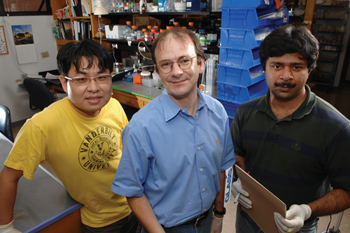
Luc Van Kaer, Ph.D., center, in the lab with study co-authors Sungjune Kim, left, and Saif Lalani. (photo by Anne Rayner)
Paralyzed immune cells may hamper some therapies
Immune cells “paralyzed” after an encounter with invading bacteria may hold important lessons for developing vaccines and cancer therapies, according to a recent study by Vanderbilt Medical Center researchers.
In the June issue of the Journal of Clinical Investigation, Luc Van Kaer, Ph.D., and colleagues demonstrate how bacteria cause this unusual set of immune cells, called invariant natural killer T cells (iNKT cells), to shut down and become inactive — an insult that may interfere with therapies aimed at these cells.
Invariant NKT cells help protect against infectious agents and cancer and regulate allergic responses and other types of unwanted inflammation. While they belong to the larger family of immune cells known as T cells, they have several unique features.
Conventional T cells recognize fragments of proteins from invading pathogens, such as bacteria and viruses. This recognition spurs the immune system into action, and the T cells can either destroy the infected cells directly or produce chemicals (cytokines) that recruit other types of immune cells to the infection site to help out.
But instead of pathogen protein fragments, iNKT cells recognize fat molecules, or “lipids,” and sugar-modified fat molecules, called “glycolipids.”
“What sort of glycolipids they recognize is not entirely clear yet,” said Van Kaer, a professor of Microbiology and Immunology.
One of the few compounds known to activate iNKT cells — a glycolipid called ±-galactosylceramide (±GalCer) — was isolated from sea sponges and shown to have anti-tumor and other immune modulating activities.
Van Kaer's group has used ±GalCer to understand the functions of iNKT cells, showing that these cells respond promptly to ±GalCer by rapidly expanding their numbers and spewing out cytokines. But after this initial burst of activity, they shut down quickly and stay “paralyzed” for weeks.
A second encounter with ±GalCer fails to generate a response during this time — a curious finding given the immune system's responsibility in mounting an even stronger response to a secondary exposure to a pathogen.
“Conventional T cells respond more strongly the second time around, which is the basis for vaccines,” Van Kaer said. “But after two days, iNKT cells don't really do too much.”
Van Kaer wondered if a “real” infection with bacteria would cause the cells to react similarly and become paralyzed. To test this, the researchers infected mice with several different bacterial species and monitored the responses of their iNKT cells.
Most of the strains tested — as well as some isolated “parts” of the bacteria — activated the cells and induced a long-lasting paralysis, or “anergy,” similar to that caused by ±GalCer.
But, Van Kaer asked, “why would you want to paralyze your iNKT cells?”
In addition to the protective actions of iNKT cells, “they also do a variety of bad things,” he explained. “They produce a lot of cytokines, contribute to hepatitis and atherosclerosis, and exacerbate allergic reactions.”
Indeed, Van Kaer found that the paralysis of iNKT cells actually prevented experimentally induced hepatitis in mice. This paralysis, he suggests, might offer protection of its own.
“You may want to be very careful whenever you activate your iNKT cells, and only do it for a short period of time when you need them — probably during early infection … to get the immune system going — and then shut them down at least for a little while. If you overstimulate them, they probably cause more damage than good.”
However, paralysis of these cells — either by bacterial infection or vaccination — can also limit the effectiveness of therapies designed to target iNKT cells like ±GalCer, which is currently in clinical trials as an anti-tumor agent. In mice with a systemic bacterial infection and implanted with tumors, Van Kaer's group showed that ±GalCer treatment had no effect on tumor growth.
In fact, “there was a tendency for tumors to get a little bit larger,” he said. “So you want to be careful in treating people with a recent infection with ±GalCer. You might actually make things worse rather than better.”
Study co-authors were: Sungjune Kim, Saif Lalani, Vrajesh Parekh, Ph.D., Tiffaney Vincent and Lan Wu, M.D.
The work was supported by grants from the National Institutes of Health, the American Diabetes Association and the National Multiple Sclerosis Society of America.













